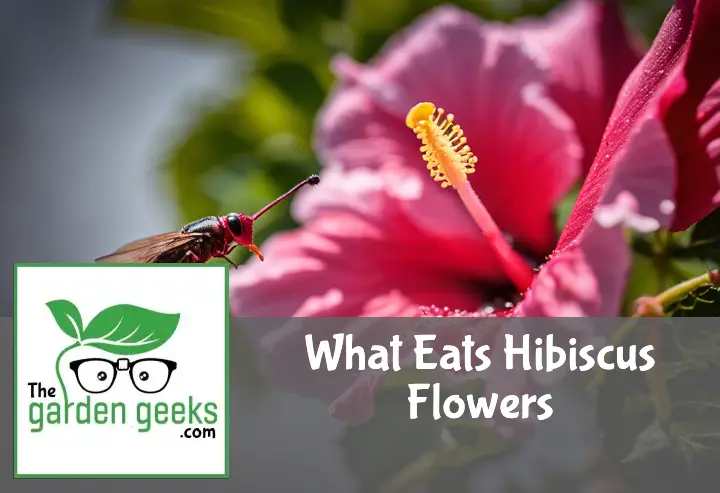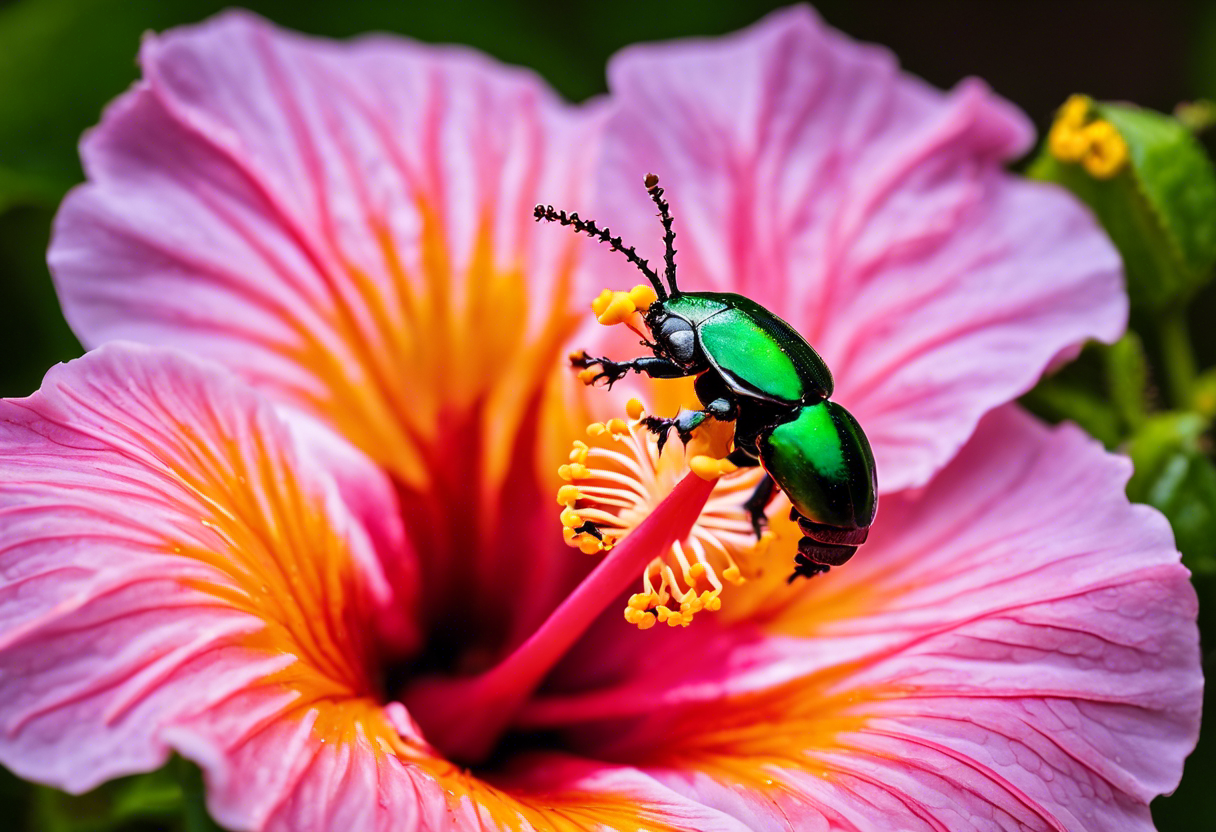Ever found yourself staring at a hibiscus flower, sipping your morning coffee, and thought, “Hmm, I wonder What Eats Hibiscus Flowers?” Well, you’re not alone! It’s one of those quirky questions that pop up in our heads from time to time.
Stick around as we delve into the world of hibiscus predators. From bugs to birds and even some mammals – you’ll be surprised who’s munching on your favorite tropical blooms! So, are you ready to find out what eats hibiscus flowers? Keep reading!
Key Takeaways
- Various insects, such as aphids, beetles, and caterpillars, eat hibiscus flowers.
- Certain animals like squirrels and deer also consume hibiscus.
- Some bird species, particularly hummingbirds, feed on the nectar of hibiscus flowers.
- Snails and slugs can damage hibiscus plants by eating their leaves and flowers.
- Invasive pests like the Hibiscus Harlequin Bug or Chinese Yellow Beetle can cause significant damage to these plants.
What Are Hibiscus Flowers?
Hibiscus flowers, with their vibrant colors and tropical allure, are native to warm-temperate, subtropical and tropical regions. They hold a special place in many cultures around the globe due to their cultural significance of hibiscus. Now let’s dive into the nitty-gritty details about these beauties.
Description and Characteristics of Hibiscus Flowers
These flowers are a sight for sore eyes with their large, trumpet-shaped blooms. The hibiscus flower color can range from white to pink, red, purple or yellow. They’re not just pretty faces though; they’re hardy too!
The size of these show-stoppers? Well, they’re no shrinking violets! The size of hibiscus flowers can reach up to 6 inches in diameter. As for their growth pattern, hibiscuses love the sun and prefer well-drained soil.
The Role of Hibiscus Flowers in the Ecosystem
Hibiscus flowers aren’t just about good looks; they play a crucial role in our ecosystem too. Their nectar-rich blossoms attract pollinators like bees and butterflies contributing to biodiversity and hibiscus flowers.
But wait there’s more! These versatile blooms have been used for centuries in traditional medicine thanks to their health benefits. From lowering blood pressure to boosting your immune system, the medicinal uses of hibiscus are vast.
And let’s not forget about food! Hibiscus petals add a tart flavor to dishes and drinks alike. So next time you sip on some refreshing hibiscus tea or munch on a salad sprinkled with its petals, remember the culinary uses of hibiscus go beyond just adding a splash of color.
Which Insects Eat Hibiscus Flowers?
When it comes to what eats hibiscus flowers, there’s a whole gang of insects that are guilty. We’re talking about aphids, whiteflies, thrips, caterpillars and beetles. These insects eating hibiscus flowers are the most common hibiscus pests you’ll encounter in your garden.
Aphids on Hibiscus Flowers
Aphids are tiny green or black bugs that love to feast on hibiscus plants. An aphid infestation on hibiscus can cause leaves to curl and yellow. You might also see a sticky substance called honeydew on your plants – that’s a surefire sign of aphids.
But don’t panic! There are ways to manage these pesky critters. You can use insecticidal soap or neem oil for treating aphids on hibiscus plants. And remember, prevention is better than cure! Regularly inspecting your plants and maintaining good garden hygiene can help in preventing aphids on hibiscus.
Whiteflies on Hibiscus Flowers
Whiteflies are another nuisance for our beloved hibiscuses. These tiny winged insects suck the sap from the plant causing wilting and yellowing of leaves. If you notice a cloud of tiny white insects flying off when you shake your plant, you’ve got yourself a whitefly problem in hibiscus plants.
But fear not! Whiteflies can be controlled with insecticidal soaps or oils too. It’s also important to remove any heavily infested leaves to prevent further spread. So keep an eye out for these pests and take action early to prevent a full-blown whitefly infestation.
Thrips on Hibiscus Flowers
Thrips are small, slender insects that cause thrip damage on hibiscuses by sucking plant juices and causing discoloration and distortion of the flowers. If you see tiny black specks on your hibiscus, it’s likely you’re dealing with thrips.
Controlling these pests can be a bit tricky due to their small size and tendency to hide within flower buds. However, insecticidal soaps or neem oil can help in controlling thrips on flowering plants. Regularly pruning your plants and removing dead leaves can also aid in preventing thrip infestations.
Caterpillars and Beetles on Hibiscus Flowers
Caterpillars and beetles are other culprits that munch on hibiscus flowers. Signs of a caterpillar infestation on hibiscus include chewed leaves and flowers, while beetle damage on hibiscus plants often presents as holes in the leaves or petals.
To manage these pests, handpicking is an effective method for larger insects like caterpillars and beetles. For smaller infestations, insecticidal soaps or oils can be used for treating caterpillars and beetles on hibiscus. And as always, maintaining good garden hygiene is key in preventing pests on flowering plants.
Which Birds Eat Hibiscus Flowers?
Well, let’s dive right into the world of feathered friends with a penchant for hibiscus flowers. You see, these vibrant blooms aren’t just pretty to look at; they’re also a tasty treat for certain bird species. Their feeding habits often lead them straight to these colorful plants, and boy oh boy, do they love ’em!
Hummingbirds and Their Attraction to Hibiscus
First up on our list is the ever-fluttering hummingbird. These tiny dynamos are particularly drawn to hibiscus flowers. Why you ask? Well, it’s all about that sweet nectar! Yep, hummingbirds are nectar feeding champs and hibiscus flowers are like their favorite fast-food joint.
Their flower preference isn’t just about taste though. The bright colors and large petals of hibiscus flowers make an excellent landing pad for these little guys. Plus, the shape of the flower is perfect for their long beaks – it’s like nature designed a custom snack bar just for them!
Other Bird Species That Feed on Hibiscus
But hey, don’t think hummingbirds are the only ones enjoying this floral feast! There are other bird species that also find hibiscus irresistible. For instance, Orioles and Finches have been known to nibble on these beauties too.
Their feeding patterns might differ from hummingbirds – they’re not as much into nectar – but they still find plenty of yumminess in hibiscus flowers. Whether it’s the seeds or the petals themselves, different birds have different reasons for their attraction to these plants.
So next time you spot a bird near your hibiscus plant, don’t shoo it away! It might just be stopping by for a quick snack. And who knows, you might even learn a thing or two about what eats hibiscus flowers.
Do Mammals Eat Hibiscus Flowers?
Well, the answer to ‘What Eats Hibiscus Flowers?’ isn’t just restricted to insects or birds. You’ll be surprised to know that some mammals also have a taste for these vibrant blooms. Yes, you heard it right! Certain types of mammals do indulge in hibiscus consumption, and their dietary choices can have quite an impact on the plant.
Common Mammals That May Consume Hibiscus
Now, let’s get down to the nitty-gritty. Which common mammals are we talking about here? Well, it’s mostly your garden variety critters like rabbits and deer. These little fellas seem to find hibiscus flowers quite irresistible.
Why so? Well, hibiscus flowers are rich in nutrients and have a sweet taste that these animals find appealing. So, if you’ve been noticing your hibiscus plants looking a bit nibbled on, now you know who the likely culprits are!
Impact of Mammalian Consumption on the Plant
Alrighty then! Now onto how this mammalian munching affects our beloved hibiscus plants. When these furry creatures snack on the flowers, it can cause some noticeable changes in the plant.
First off, frequent feeding can lead to stunted growth as the plant loses vital nutrients. Plus, excessive nibbling can damage the flower buds and leaves affecting overall plant health.
But don’t worry too much! Hibiscus plants are pretty resilient and can bounce back from occasional feeding bouts. Just keep an eye out for any signs of overgrazing and take necessary measures if needed. After all, we want our hibiscuses blooming beautifully without turning into a free salad bar for local wildlife!
How to Protect Your Hibiscus From Predators?
Ever wondered what eats hibiscus flowers? Well, a bunch of pesky critters do. And let me tell you, protecting hibiscus from these predators is no walk in the park. But don’t fret! We’ve got two main strategies for you: natural and chemical methods. Both are effective ways to ensure your precious blooms stay safe.
Natural Methods for Pest Control
Now, if you’re all about that green life, natural pest control might be your jam. There’s a whole array of organic methods out there that can help keep those nibbling nuisances at bay. For instance, introducing beneficial insects like ladybugs and lacewings into your garden can work wonders.
These little heroes love munching on pests that harm your hibiscus. Plus, they’re pretty darn cute too! Another eco-friendly solution involves using non-toxic sprays made from ingredients like garlic or hot pepper. These sprays deter pests without harming the environment or your plants.
Chemical Methods for Pest Control
On the other hand, if you’re dealing with a serious infestation or just want quick results, chemical pest control could be the way to go. Synthetic pesticides pack a punch against those pesky bugs but remember to use them responsibly!
There’s a wide range of effective insecticides available in the market today. Some are specifically designed for flower protection and are perfect for safeguarding your hibiscus plants.
Applying these products isn’t rocket science either! Just follow the pesticide application process mentioned on the label and voila! Your hibiscus is now under some serious chemical protection.
To Wrap Up
We’ve unlocked the mystery of What Eats Hibiscus Flowers. From cheeky squirrels and hungry deer to colorful birds and busy insects, it’s like a bustling supermarket for wildlife!
Remember, your hibiscus isn’t just a pretty face in your garden; it’s also a crucial snack stop for many critters. So next time you see nibbled flowers, don’t fret – you’re simply hosting a wild feast!



